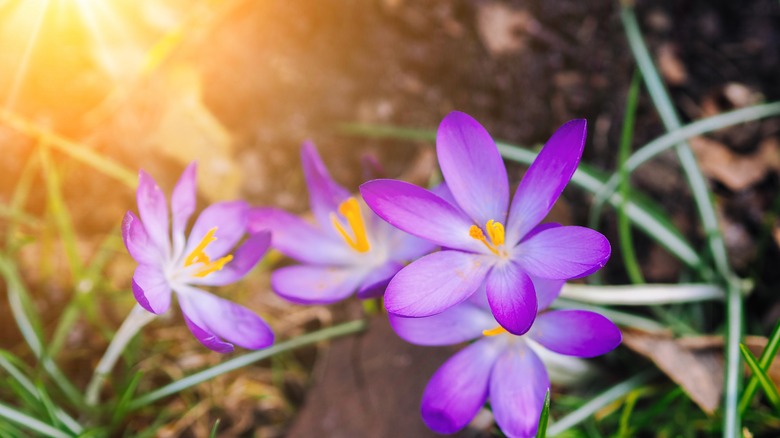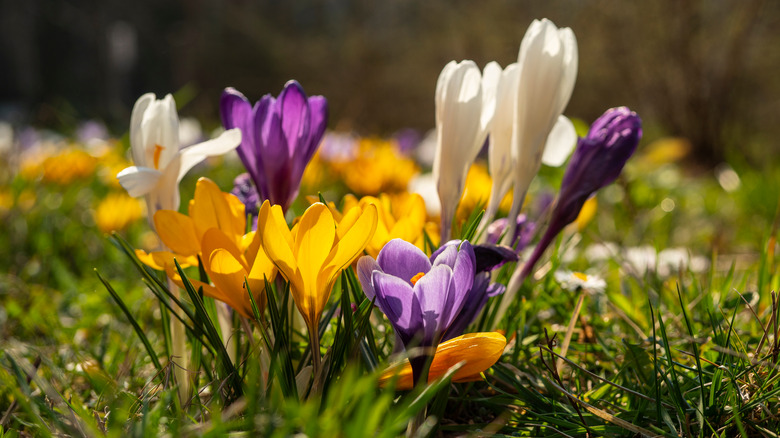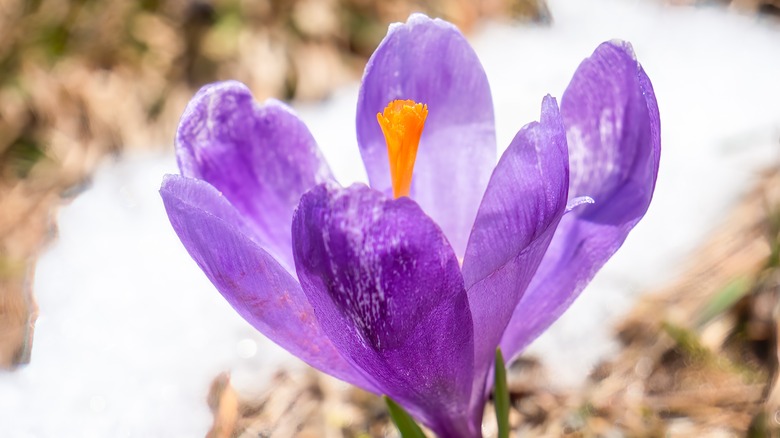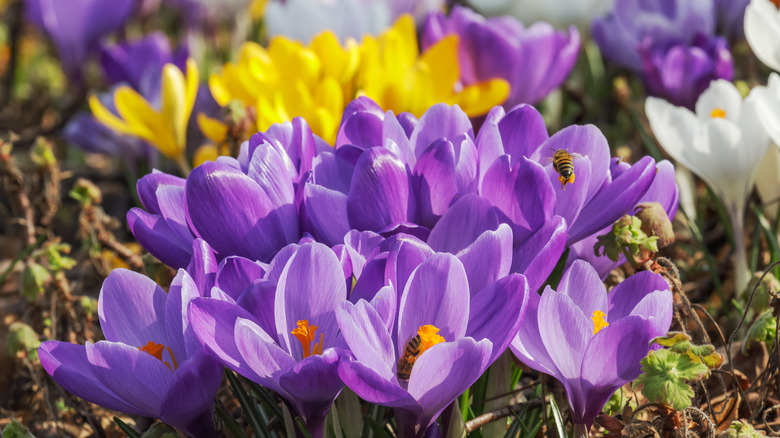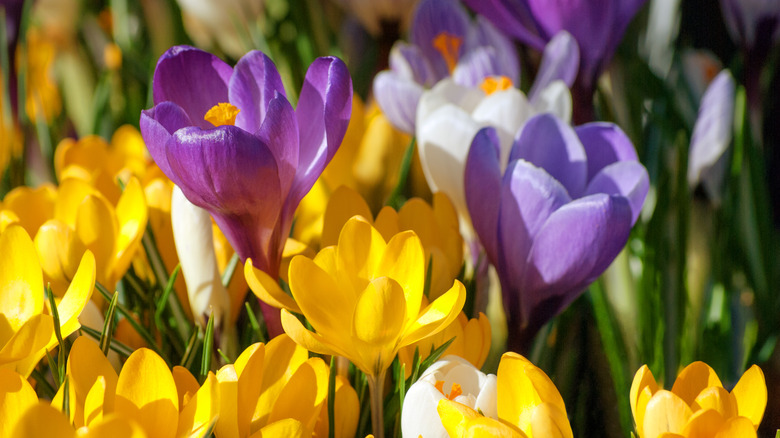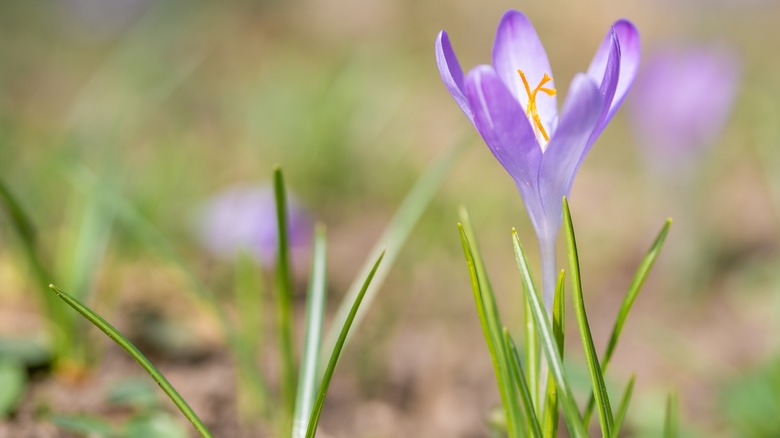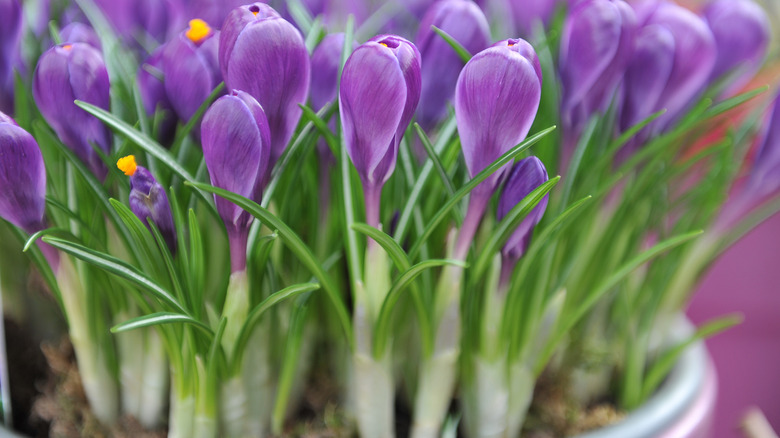How To Care For A Crocus Flower
Nothing announces the imminent arrival of spring quite like the tiny, colorful heads of flowers coming through the (often still snow-covered) ground. Crocus spp, or crocus, is no exception and is a popular choice among gardeners due to its tendency to be one of the first perennial plants to make an appearance after a long, snowy winter. Its bright, varying shades of purples, yellows, and whites enhance the look of your garden and provide a much-needed pop of color after the gloomy winter months. Additionally, its strong fragrance lures bees out of their hives for the season in February and March, offering a vital food source for the pollinators in early spring, per Garden Design.
Crocus plants are also popular among gardeners due to being low-maintenance and easy to grow, making them a staple among experienced gardeners and the perfect choice for novice gardeners looking to brighten up their yard with some spring bulbs.
How to use crocus flower in your garden
Crocuses, like most bulbs, should be planted in groups to make an eye-catching impact since these types of single flowers can easily get lost and overpowered by other plants in a traditional garden landscape. Ten or more corms planted together, several inches apart, should be enough to make a colorful, springtime statement. Due to their relatively short height of 2 to 4 inches tall, crocus flowers should be planted in the front of a garden display if placed among taller plants that could easily overwhelm and conceal them.
Though many people often plant bulbs in rows to create dramatic lines of color, High Country Gardens recommends planting your crocus corms in informal groups instead to create a more relaxed display that is often more visually pleasing than uniform rows. Randomly scattering them over an area and allowing them to grow where they land is an easy way to ensure they bloom in a way that looks natural and beautiful.
How to grow crocus flower
In order to fully bloom, crocuses need to be exposed to cold weather for a short period of time, so Almanac says they should be planted in the fall to guarantee springtime blooms. Just be sure you get them in the ground before it freezes.
Crocus bulbs, technically called corms, should be planted 3 to 4 inches deep with the pointy end of the corm facing upward. After the corms are in the ground, cover the area with mulch before the first snowfall, per HGTV. The mulch should be removed before spring, around February, so the chutes can come through more easily when it is time for them to make an appearance.
Once planted, water the area well. Crocuses grow best when planted in well-draining soil, as the corms can rot if they are planted in an area that is too soggy. The soil should still be kept wet throughout the fall to prevent the corms from getting dry. They grow best when planted in areas that can receive at least six hours of full sun every day but will tolerate partial sun if you do not have the option for full sun.
How to care for crocus flower
Crocuses are popular due to not requiring much maintenance to thrive. As long as they are given the proper amount of sunlight and water, you can expect your crocuses to grow well. Keep in mind that if you live in an area that doesn't have snow cover in the winter, you will need to water your crocuses just as you would during the warmer months, ensuring you keep the soil moist but not overly saturated.
Just like other bulbs, crocuses do not require deadheading or trimming. In fact, you should refrain from trimming the leaves or any other part of the plant until it turns completely yellow, per The Spruce. Crocuses receive nutrients from the dying foliage and allowing your plant access to these nutrients is essential in ensuring it will continue to thrive and return every year.
Crocuses do not require a lot of fertilizer, but Gardening Know How suggests applying a balanced fertilizer in early autumn if spring doesn't last long in your area and the weather heats up quickly. Alternatively, you can supply fertilizer in late winter if your region's springtime is long and temperate. The additional nutrients ensure you have a strong, healthy plant year after year.
Crocus flower varieties
Crocuses belong to the Iridaceae, or iris family, and there are more than 80 known species of this flower, per The Spruce. Despite this number, most commercially sold crocuses are hybrids that are crossbred from a smaller selection of plants with highly desirable traits.
Among those popular varieties, Almanac recommends the following for use in gardens:
- 'Bowles White': This variety grows white flowers in early spring. The plant reaches 2 to 3 inches in height.
- 'Flower Record': This variant has single pale violet flowers that bloom from spring to early summer. It can grow to be 4 to 5 inches tall.
- 'Pickwick': This species has pale and purple stripes and also blooms from spring to early summer. It can be 4 to 5 inches tall.
- 'Tricolor Crocus': This variety produces narrow flowers, each with three bands of purple, white, and yellow. It blooms in late winter and early spring and grows to be 3 inches tall.
- 'Purpureus Grandiflorus': This variety produces violet flowers with purple bases. It blooms from spring to early summer and reaches heights of 4 to 5 inches.
Is crocus flower toxic?
Though there have been no reported cases of crocuses causing toxicity in humans, these plants are noted by ASPCA to be toxic to pets. If your pet ingests any part of the plant, they may experience gastrointestinal upset, which can lead to symptoms like vomiting, diarrhea, and drooling. Severe symptoms are also possible and can include excessive vomiting and diarrhea and kidney, liver, and bone marrow damage. All parts of a crocus contain toxins that can make your pet sick if ingested. That being said, most of the toxins are found in the actual corm, making it especially important to prevent your pet from gaining access to this part of the plant.
The best practice for pet owners who love to garden is to simply keep all furry friends away from the garden entirely, especially if they are prone to exploring the world through their mouths. This will prevent them from getting into any plants that can make them sick.
How to repot crocus flower
Due to their small size, crocuses are an excellent candidate for indoor growth and cultivation. Thumb Garden suggests selecting the largest, most mature corms to plant indoors — at least 1 inch in diameter. Planting only the best selection of corms will ensure they have the greatest chance of survival in an indoor setting.
If you want your indoor crocus to flower in February, plant it in early October. For winter flowering, plant during mid-September. If you are aiming to have flowers by March, you can postpone indoor planting until November. Just like you would plant crocuses in your garden, you should plant your indoor crocuses in groups as well — shoot for groups of at least five. This will ensure your container is properly filled with color and will help make your indoor display as beautiful and eye-catching as possible.
Your indoor crocuses should remain rooted in their container for about two to three months, during which time they should receive shade and cool temperatures, similar to what they would experience outdoors during the fall and winter months. After the flowers start to fully bloom, you can move your crocuses to a location with warmer temperatures or plant them outside.
